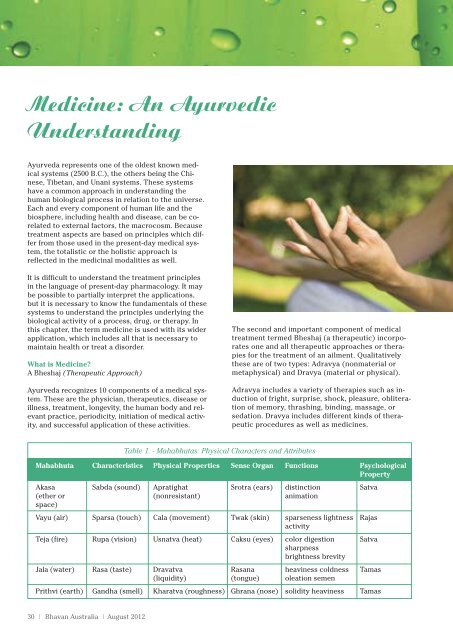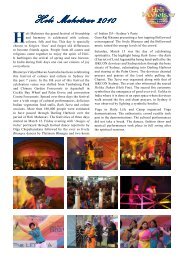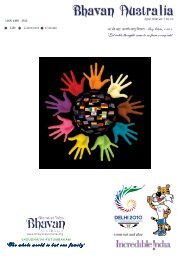World Peace - Bharatiya Vidya Bhavan Australia
World Peace - Bharatiya Vidya Bhavan Australia
World Peace - Bharatiya Vidya Bhavan Australia
Create successful ePaper yourself
Turn your PDF publications into a flip-book with our unique Google optimized e-Paper software.
Medicine: An Ayurvedic<br />
Understanding<br />
Ayurveda represents one of the oldest known medical<br />
systems (2500 B.C.), the others being the Chinese,<br />
Tibetan, and Unani systems. These systems<br />
have a common approach in understanding the<br />
human biological process in relation to the universe.<br />
Each and every component of human life and the<br />
biosphere, including health and disease, can be corelated<br />
to external factors, the macrocosm. Because<br />
treatment aspects are based on principles which differ<br />
from those used in the present-day medical system,<br />
the totalistic or the holistic approach is<br />
reflected in the medicinal modalities as well.<br />
It is difficult to understand the treatment principles<br />
in the language of present-day pharmacology. It may<br />
be possible to partially interpret the applications,<br />
but it is necessary to know the fundamentals of these<br />
systems to understand the principles underlying the<br />
biological activity of a process, drug, or therapy. In<br />
this chapter, the term medicine is used with its wider<br />
application, which includes all that is necessary to<br />
maintain health or treat a disorder.<br />
What is Medicine?<br />
A Bheshaj (Therapeutic Approach)<br />
Ayurveda recognizes 10 components of a medical system.<br />
These are the physician, therapeutics, disease or<br />
illness, treatment, longevity, the human body and relevant<br />
practice, periodicity, initiation of medical activity,<br />
and successful application of these activities.<br />
30 | <strong>Bhavan</strong> <strong>Australia</strong> | August 2012<br />
Table 1. - Mahabhutas: Physical Characters and Attributes<br />
The second and important component of medical<br />
treatment termed Bheshaj (a therapeutic) incorporates<br />
one and all therapeutic approaches or therapies<br />
for the treatment of an ailment. Qualitatively<br />
these are of two types: Adravya (nonmaterial or<br />
metaphysical) and Dravya (material or physical).<br />
Adravya includes a variety of therapies such as induction<br />
of fright, surprise, shock, pleasure, obliteration<br />
of memory, thrashing, binding, massage, or<br />
sedation. Dravya includes different kinds of therapeutic<br />
procedures as well as medicines.<br />
Mahabhuta Characteristics Physical Properties Sense Organ Functions Psychological<br />
Property<br />
Akasa Sabda (sound) Apratighat Srotra (ears) distinction Satva<br />
(ether or<br />
space)<br />
(nonresistant) animation<br />
Vayu (air) Sparsa (touch) Cala (movement) Twak (skin) sparseness lightness Rajas<br />
activity<br />
Teja (fire) Rupa (vision) Usnatva (heat) Caksu (eyes) color digestion<br />
sharpness<br />
brightness brevity<br />
Satva<br />
Jala (water) Rasa (taste) Dravatva Rasana heaviness coldness Tamas<br />
(liquidity) (tongue) oleation semen<br />
Prithvi (earth) Gandha (smell) Kharatva (roughness) Ghrana (nose) solidity heaviness Tamas









